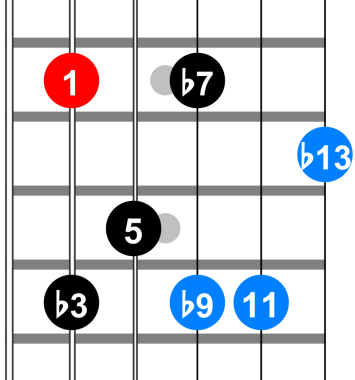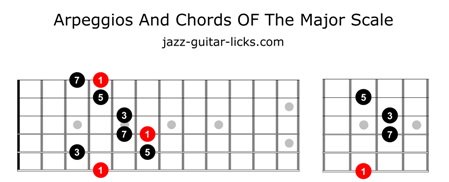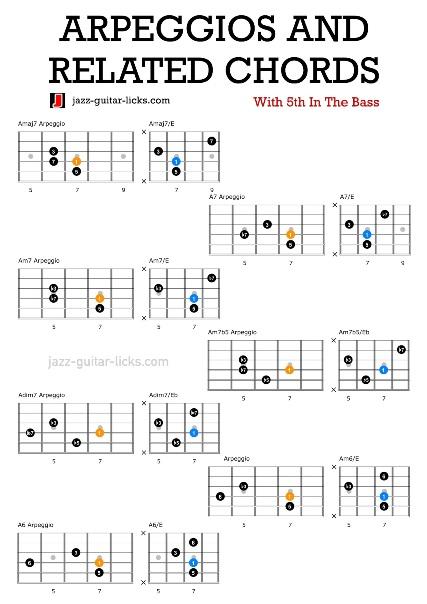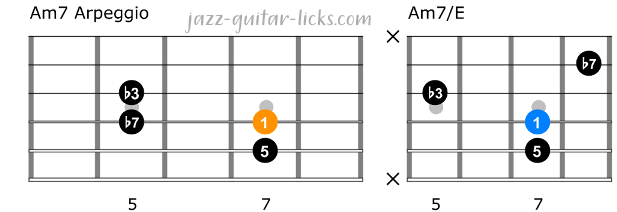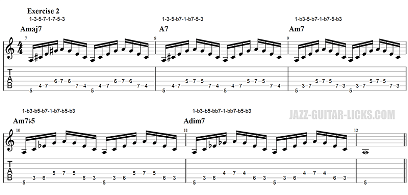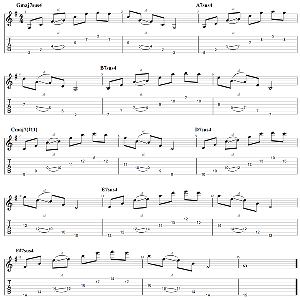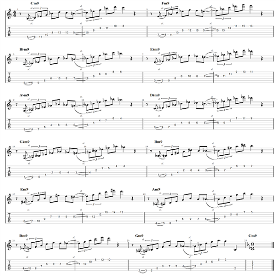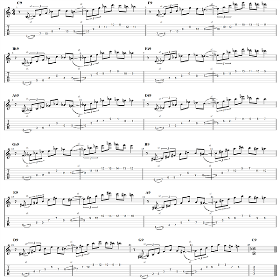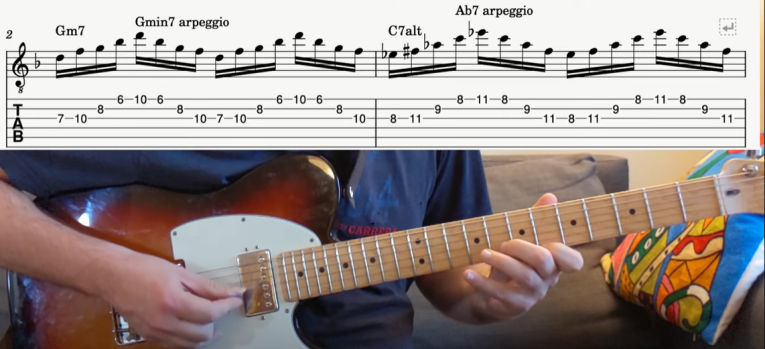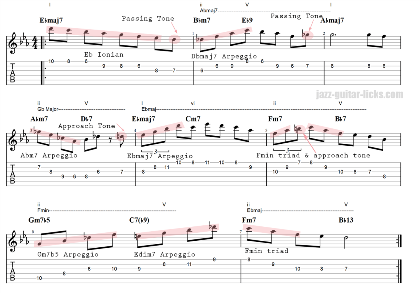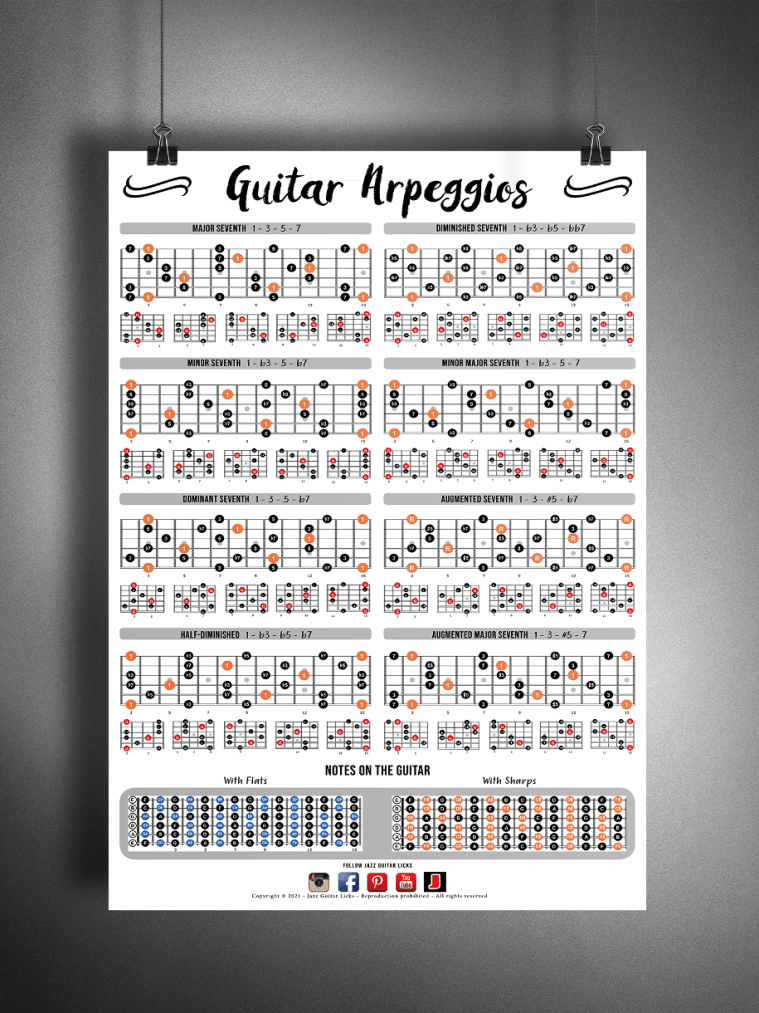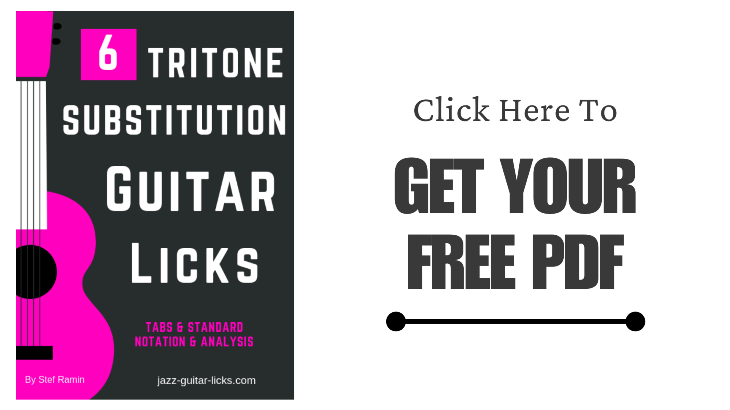arpeggios
-
Diatonic Sixth Chords And 6add9 Arpeggios For Guitar
- By jazz-guitar-licks
- On 2025-07-04
- 0 comments
In this lesson, you will learn how to harmonize the major scale in sixth chords and 6add9 arpeggios to add a smooth, jazzy flavor to your playing.
Free PDF available here.
-
Harmonic Minor Scale Arpeggio And Chord Shapes For Guitar
- By jazz-guitar-licks
- On 2025-06-17
- In Scales & Arpeggios
- 0 comments
Welcome to this guitar lesson on exploring the arpeggios and chords of the harmonic minor scale—a rich and expressive sound widely used in classical, metal, jazz, and fusion genres
In this lesson, we'll dive into how this scale builds unique chords and arpeggios, including the diminished and augmented types you won’t find in major or natural minor harmony.
You'll learn how to visualize these shapes across the fretboard.
-
Diatonic Seventh Arpeggios And Extensions For Guitar - PDF & Short Video
- By jazz-guitar-licks
- On 2024-12-13
- 0 comments
In this guitar lesson with PDF and Youtube Short, you'll learn how to extend diatonic seventh arpeggios with the 9th, 11th and 13th.
Check this link to get the PDF transcription.
-
Diatonic Arpeggios - Guitar Exercise With Tab And YouTube Short
- By jazz-guitar-licks
- On 2024-10-29
- In Scales & Arpeggios
- 0 comments
In this guitar lesson with tab and YouTube short we’re diving into diatonic arpeggios, focusing on playing them in a fixed position.
-
Arpeggios And Chords Of The Major Scale For Guitar - Free PDF
- By jazz-guitar-licks
- On 2024-09-23
- In Scales & Arpeggios
- 0 comments
Here’s a breakdown of seventh arpeggios and their related chords based on the major scale for guitar.
An arpeggio is essentially the notes of a chord played individually.
Seventh arpeggios add a fourth note (the seventh) to each triad, giving a more complex and richer sound.
In this guitar lesson, we'll be focusing on the arpeggios of the seventh chords derived from the G major scale.
You'll find the free PDF (or name a fair price) here in the GUMROAD Store.
-
Major 9 Arpeggio Guitar Lick With Chromatic Passing Tones / Free PDF
- By jazz-guitar-licks
- On 2024-07-31
- 2 comments
This lesson with free PDF (or give what you want) proposes an easy jazz guitar lick built with an A major 9 arpeggio A (1), C# (3), E (5), G# (7), B (9) including two passing tones Bb (b2 / b9) and G (b7).
-
Arpeggios And Related Chords On Guitar - Cheat Sheet
- By jazz-guitar-licks
- On 2024-04-27
- In Guitar Cheat Sheets, Methods, eBooks, Posters
- 0 comments
Here is a free printable sheet cheat for guitar showing the relation between the main types of arpeggios and chord voicings with fifth in the bass.
-
Arpeggio And Chord Connection - Maj7, 7, min7, m7b5, dim7, min6 and 6 - Warm-up Exercise For Beginners
- By jazz-guitar-licks
- On 2023-09-06
- 0 comments
Arpeggios are a fundamental aspect of music theory and play a pivotal role in creating expressive melodies, harmonies, and improvisations across various musical genres. In this exploration of basic arpeggios, we will learn how to connect Maj7, 7, min7, m7b5, dim7, min6, and 6 arpeggios (by moving only one note at a time) and how to make the link with basic chord shapes.
-
13 Arpeggio Exercises For Guitar - Major 7, Dominant 7, Minor 7, Half-diminished, Diminished 7
- By jazz-guitar-licks
- On 2023-04-07
- In Scales & Arpeggios
- 0 comments
This guitar lesson propose 13 exercices implying the five main types of arpeggios (major 7, dominant 7, minor 7, half-diminished and diminished 7) to both preparing your hands, learning your fretboard and hearing the color of each arpeggio.
Free PDF Available Here On GUMROAD.
-
Dominant Bebop Scale, Rootless Chords And Arpeggios - PDF With Tab And Video
- By jazz-guitar-licks
- On 2023-01-17
- In Licks & Transcriptions
- 0 comments
This guitar lesson provides a 12-bar study (free PDF and short video) for practicing the dominant bebop scale, some rootless chords and also three types of arpeggios (min7, dom7 and half-diminished) over a turnaround variation.
-
Three Note Arpeggios Built In Fourths On Guitar - Quartal Harmony - Guitar Lesson With YouTube Short Video and PDF
- By jazz-guitar-licks
- On 2022-03-24
- 0 comments
Quartal harmony is the way of building chords with intervals of fourths instead of thirds, it's a nice way to modernize and enrich your jazz guitar playing. This post provides an easy exercise for a first approach of quartal playing that is to arpeggiate three-note chords built in fourths, starting on each step of a major scale.
As is the case in many lessons on the website, you'll find a short YouTube video and the link to download the PDF for free, a little further in this article.
-
Minor Ninth Arpeggio Workout - Guitar Exercise With TAB / PDF / VIDEO
- By jazz-guitar-licks
- On 2022-02-28
- In Scales & Arpeggios
- 0 comments
This exercise is the third of the serie covering ninth arpeggio practice around the cycle of fourths on guitar. While the previous two lessons dealt with major ninth and dominant ninth arpeggios, this one is about minor ninth arpeggios. As usual you'll find the related PDF transcription for free, here in the GUMROAD STORE.
-
Dominant 9th Arpeggios and Cycle Of Fourths
- By jazz-guitar-licks
- On 2022-02-03
- In Jazz Guitar Lessons
- 0 comments
This short guitar tutorial is about to play a 2-bar line built from a dominant ninth arpeggio pattern around the cycle of fourths. This lesson comes with a short video available on Jazz Guitar Licks social networks as Youtube, Facebook or Instagram (link at the top of this website). You can also get the free PDF tab in the GUMROAD shop.
-
Rhythm and Picking Arpeggio Exercise For Guitar
- By jazz-guitar-licks
- On 2022-01-30
- In Teacher Spotlight - Jazz Guitar Lessons
- 0 comments
Lesson by George Nazos
In this short video lesson with tab, George proposes a guitar lick/exercise in rhythm and picking. He shows how to use different subdivisions in arpeggios following a 2 5 1 6 chord progression while using substitution for the dominant arpeggios from the altered scale.
-
Arpeggios Over II V I and I VI II V Chord Changes - Guitar Lesson With PDF, Shapes and Video (part 2)
- By jazz-guitar-licks
- On 2021-11-13
- In Jazz Guitar Lessons
- 0 comments
In this guitar lesson with shapes, tab, video and analysis you will learn how to use seventh arpeggios over important jazz chord sequences as minor & major II V , major II V I and I vi ii V progressions.
You'll find the link to the PDF at the bottom of the page.
-
Arpeggios On Guitar - Giant Poster
- By jazz-guitar-licks
- On 2021-10-05
- In Guitar Cheat Sheets, Methods, eBooks, Posters
- 0 comments
A new guitar poster referencing the most used arpeggios shapes is available on Jazz Guitar Licks Teespring Store. This reference chart includes 50 diagrams to help guitarists figure out arpeggio positions all over the guitar neck. The size of this poster is 24 x 36 inches (60 x 90 cm), the arpeggio types covered are:
- Major 7
- Minor 7
- Dominant 7
- Half-diminished
- Diminished 7
- Minor Major 7
- Augmented Major 7
- Augmented 7
